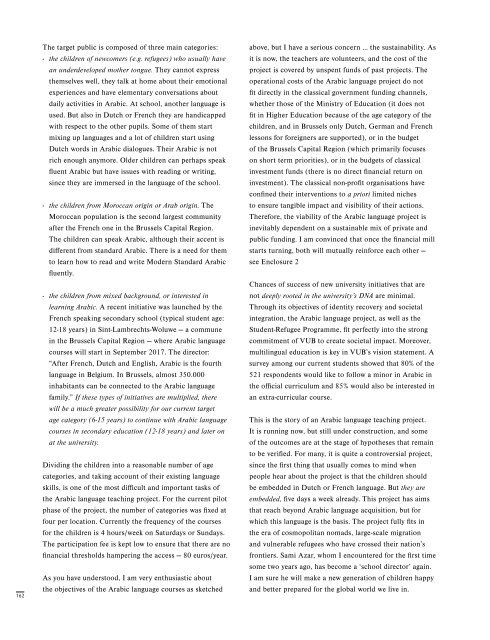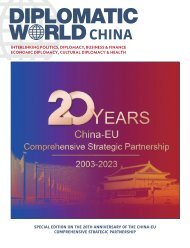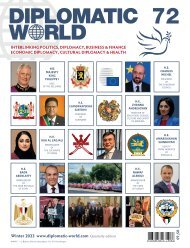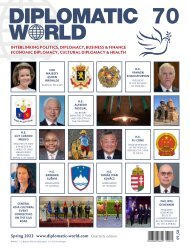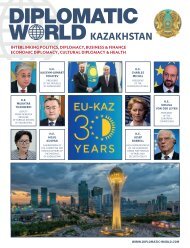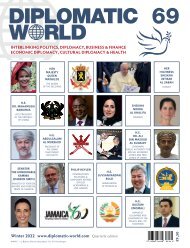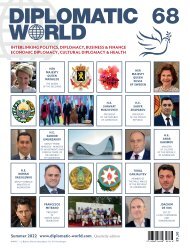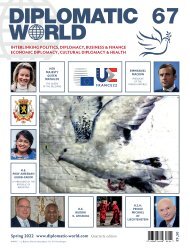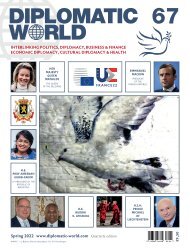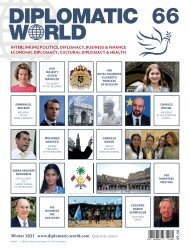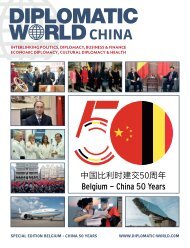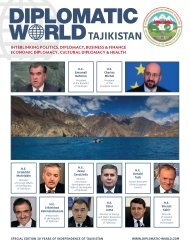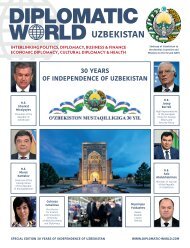Diplomatic World nummer 54
You also want an ePaper? Increase the reach of your titles
YUMPU automatically turns print PDFs into web optimized ePapers that Google loves.
162<br />
The target public is composed of three main categories:<br />
- the children of newcomers (e.g. refugees) who usually have<br />
an underdeveloped mother tongue. They cannot express<br />
themselves well, they talk at home about their emotional<br />
experiences and have elementary conversations about<br />
daily activities in Arabic. At school, another language is<br />
used. But also in Dutch or French they are handicapped<br />
with respect to the other pupils. Some of them start<br />
mixing up languages and a lot of children start using<br />
Dutch words in Arabic dialogues. Their Arabic is not<br />
rich enough anymore. Older children can perhaps speak<br />
fluent Arabic but have issues with reading or writing,<br />
since they are immersed in the language of the school.<br />
- the children from Moroccan origin or Arab origin. The<br />
Moroccan population is the second largest community<br />
after the French one in the Brussels Capital Region.<br />
The children can speak Arabic, although their accent is<br />
different from standard Arabic. There is a need for them<br />
to learn how to read and write Modern Standard Arabic<br />
fluently.<br />
- the children from mixed background, or interested in<br />
learning Arabic. A recent initiative was launched by the<br />
French speaking secondary school (typical student age:<br />
12-18 years) in Sint-Lambrechts-Woluwe — a commune<br />
in the Brussels Capital Region — where Arabic language<br />
courses will start in September 2017. The director:<br />
“After French, Dutch and English, Arabic is the fourth<br />
language in Belgium. In Brussels, almost 350.000<br />
inhabitants can be connected to the Arabic language<br />
family.” If these types of initiatives are multiplied, there<br />
will be a much greater possibility for our current target<br />
age category (6-15 years) to continue with Arabic language<br />
courses in secondary education (12-18 years) and later on<br />
at the university.<br />
Dividing the children into a reasonable number of age<br />
categories, and taking account of their existing language<br />
skills, is one of the most difficult and important tasks of<br />
the Arabic language teaching project. For the current pilot<br />
phase of the project, the number of categories was fixed at<br />
four per location. Currently the frequency of the courses<br />
for the children is 4 hours/week on Saturdays or Sundays.<br />
The participation fee is kept low to ensure that there are no<br />
financial thresholds hampering the access — 80 euros/year.<br />
As you have understood, I am very enthusiastic about<br />
the objectives of the Arabic language courses as sketched<br />
above, but I have a serious concern … the sustainability. As<br />
it is now, the teachers are volunteers, and the cost of the<br />
project is covered by unspent funds of past projects. The<br />
operational costs of the Arabic language project do not<br />
fit directly in the classical government funding channels,<br />
whether those of the Ministry of Education (it does not<br />
fit in Higher Education because of the age category of the<br />
children, and in Brussels only Dutch, German and French<br />
lessons for foreigners are supported), or in the budget<br />
of the Brussels Capital Region (which primarily focuses<br />
on short term priorities), or in the budgets of classical<br />
investment funds (there is no direct financial return on<br />
investment). The classical non-profit organisations have<br />
confined their interventions to a priori limited niches<br />
to ensure tangible impact and visibility of their actions.<br />
Therefore, the viability of the Arabic language project is<br />
inevitably dependent on a sustainable mix of private and<br />
public funding. I am convinced that once the financial mill<br />
starts turning, both will mutually reinforce each other —<br />
see Enclosure 2<br />
Chances of success of new university initiatives that are<br />
not deeply rooted in the university’s DNA are minimal.<br />
Through its objectives of identity recovery and societal<br />
integration, the Arabic language project, as well as the<br />
Student-Refugee Programme, fit perfectly into the strong<br />
commitment of VUB to create societal impact. Moreover,<br />
multilingual education is key in VUB’s vision statement. A<br />
survey among our current students showed that 80% of the<br />
521 respondents would like to follow a minor in Arabic in<br />
the official curriculum and 85% would also be interested in<br />
an extra-curricular course.<br />
This is the story of an Arabic language teaching project.<br />
It is running now, but still under construction, and some<br />
of the outcomes are at the stage of hypotheses that remain<br />
to be verified. For many, it is quite a controversial project,<br />
since the first thing that usually comes to mind when<br />
people hear about the project is that the children should<br />
be embedded in Dutch or French language. But they are<br />
embedded, five days a week already. This project has aims<br />
that reach beyond Arabic language acquisition, but for<br />
which this language is the basis. The project fully fits in<br />
the era of cosmopolitan nomads, large-scale migration<br />
and vulnerable refugees who have crossed their nation’s<br />
frontiers. Sami Azar, whom I encountered for the first time<br />
some two years ago, has become a ‘school director’ again.<br />
I am sure he will make a new generation of children happy<br />
and better prepared for the global world we live in.


